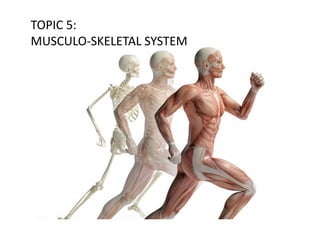
Topic 5 Muscular System
- 1. TOPIC 5: MUSCULO-‐SKELETAL SYSTEM
- 2. Learning outcomes 1. IdenAfy types of muscle Assues 2. Describe types of skeletal system 3. IdenAfy human skeletal system 4. IdenAfy the component of human musculo-‐skeletal system 5. Explain how muscle contracts 6. Describe muscle and bone relaAonships
- 3. topic 1. Muscle bone partnership 2. Types of muscle Assue 3. Muscle contracAon 4. Skeletal system 5. Musculo-‐skeletal system
- 5. The muscle–bone partnership • Skeletal muscles are bundles of muscle fibers that interact with bones and with one another • Tendons aQach skeletal muscles to bones AcAon of muscle: Example: Movement of the forearm at the elbow joint 1. When muscle contract they shorter 2. When muscle relaxed, they longer 3. Muscle only pull; they cannot push. 4. Both muscle work in antagonisAc pairs
- 6. Synergy Muscle • Some cause movements by working as pairs or groups (synergy) • Synergy muscle assist prime mover
- 7. Antagonist Muscle Others oppose or reverse the action of a partner muscle (antagonist)
- 9. TYPES OF MUSCLE TISSUE
- 10. Muscle Tissues: Move the Body • Muscle Assues are frequently called contracAle Assues because they contain contracAle protein filaments such as acAn and myosin. • There are three types of muscle Assues. 1. Skeletal 2. Cardiac 3. Smooth
- 11. 1. Skeletal Muscle • There are 3 types of muscle in the human body, each with a different structure. 1. Cardiac muscle, found in the heart, consists of striated, branched cells forming a la[ce. 2. Smooth muscle are long, spindle-‐shaped cells that are formed in sheets. 3. Skeletal muscle cells are elongated fibers running the length of the muscle.
- 12. 1. Cardiac muscle: • Cardiac muscle is involuntary muscle. • Cardiac muscle is found in the walls of the heart. • Cardiac muscle cells are highly branched, interconnected, and bounded on each end by intercalated disks.
- 13. 2. Smooth muscle: • Smooth muscle is involuntary muscle without striaAons. • Smooth muscle is also called visceral muscle because it lines the walls of the organs and blood vessels.
- 14. • Skeletal muscle is voluntary muscle. • Skeletal muscle is aQached to bones to facilitate movement. • Skeletal muscle cells are called fibers and are striated because of the acAn and myosin bands. 3. Skeletal muscle:
- 16. Pathway of Muscle Control
- 17. Skeletal muscle: AcAn Filaments • Skeletal muscle cells called fibers & striated because of acAn and myosin bands. • AcAn filaments consist of two chains of globular acAn monomers intertwined in a helix. • AcAn filaments support the cell and any projecAons, such as microvilli. • AcAn, and another molecule called myosin, are also involved in muscle contracAon and cell division. 2 chains of globular acAn monomer
- 19. Skeletal Muscle and Physiology
- 22. Skeletal Muscle ContracAon • In the presence of calcium, myosin binds to the acAn filaments. • The myosin head flexes inward and backward, causing the acAn filament to shorten. • In the presence of ATP, the myosin head detaches and then reaQaches at a new posiAon on the acAn filament. • This cycle repeats to conAnue the shortening of the muscle (contracAon).
- 23. Cross-‐bridge cycle 1. Acetylcholine (Ach) from a motor neuron axon terminal diffuse to the muscle fiber. 2. Calcium is transported into the sarcoplasmic reticulum 3. Presence of calcium triggers the exposure of myosin binding sites. 4. Myosin head binds to actin filaments
- 24. Cross-‐bridge cycle 5. The power stroke occurs 6. ATP binds to the myosin head 7. ATP is hydrolyzed to ADP +P, leading to the reenergizing and repositioning of the head
- 25. SKELETAL SYSTEM
- 26. Skeletal systems • ContracAle force exerted against some type of skeleton moves the animal body • Many invertebrates have a hydrostaAc skeleton, which is a fluid-‐filled body cavity • Others have an exoskeleton of hardened structures at the body surface • Vertebrates have an endoskeleton, an internal skeleton of carAlage, bone, or both
- 27. 1. HydrostaAc skeleton – A confined fluid accepts the force of muscle contracAon 2. Exoskeleton – Consists of hardened parts at the body surface 3. Endoskeleton – Consists of hardened parts inside the body
- 29. SKULL cranial bones facial bones sternum RIB CAGE ribs VERTEBRAL COLUMN vertebrae intervertebral disks PECTORAL GIRDLES AND UPPER EXTREMITIES clavicle scapula humerus radius ulna carpals metacarpals phalanges pelvic girdle femur patella tibia fibula tarsals metatarsals phalanges PELVIC GIRDLE AND LOWER EXTREMITIES
- 30. MUSCULO-‐SKELETAL SYSTEM Muscle-‐ tendon-‐bones ligaments
- 31. 1. Muscle o Long, cylindrical cells with mulAple nuclei o Form from groups of embryonic cells that fuse before they differenAate and mature o Bundled inside a dense connecAve Assue sheath
- 33. 2. Tendons o Extensions of connecAve Assue sheath o AQach skeletal muscles to bones
- 34. 3. Joints • Joints – Regions where bones meet – Most allow bones to move – Held together by ligaments • Types of joints I. Fibrous joint II. CarAlaginous joint III. Synovial joint
- 35. • Muscles generally work in antagonisAc pairs to provide movement. • Muscles arAculate movement at joints. 1. Synovial joints have a fluid filled cavity that ease fricAon as the bones move. 2. Hinged joints move only in one direcAon. 3. Ball-‐and-‐socket joints allow for rotaAonal movement.
- 40. Types of joint
- 41. Types of synovial joint and location